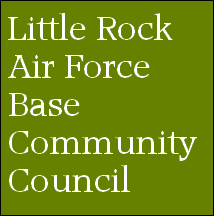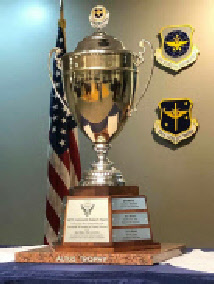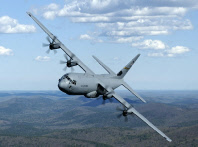

Little Rock Air Force Base Community Council
c/o Denise Goforth
P. O. Box 515
Jacksonville, AR 72078
501-681-5410.
lrafbcommunitycouncil@gmail.com
c/o Denise Goforth
P. O. Box 515
Jacksonville, AR 72078
501-681-5410.
lrafbcommunitycouncil@gmail.com
CONTACT US:





History of the Little Rock
Air Force Base Community Council
by John G. Schmidt, Little Rock AFB Historian
Air Force Base Community Council
by John G. Schmidt, Little Rock AFB Historian
The existence of Little Rock Air Force Base was a dream to a handful of people in the early 1950s. However, through patience and perseverance, that dream became a reality when the base opened its gates in 1955. How the dream became a reality is a fascinating story of the ability of the civilian community to work together toward a common goal with the United States Military establishment.
In late 1951 the Little Rock area was first considered for a permanent United States Air Force installation. It had been pointed out that Arkansas was like "the hole in a doughnut" in that it was surrounded by states which were already hosting military installations. Additionally, Arkansas was strategically located near the geographic center of the United States, almost equidistant from U. S. coastlines. This would make such an installation far less vulnerable to an attack by hostile forces. Early civilian support for such an installation was apparent. Arch Campbell, the Pulaski County Judge, and Harry W. Pfeifer, Jr., President of the Greater Little Rock Chamber of Commerce, sent a letter to Thomas K. Finletter, the Secretary of the Air Force, on January 11, 1952. In that letter they discussed reasons the Little Rock area would be ideal for locating a permanent Air Force facility. When it was determined that the Air Force was interested in the area, Everett Tucker, the Little Rock Chamber of Commerce Industrial Manager, was instrumental in laying the ground-work in site selection. Mr. Tucker flew to Washington D. C. and to Strategic Air Command Headquarters at Offut AFB, Nebraska, to further the planning for the construction of the base.
The Air Force agreed with the proposal; however, Congress refused to allocate monies for the purchase of properties to house such an installation. Congress reflected the opinion that enough installations were left over from World War II that purchase of new properties was unwarranted. The Air Force suggested, however, that if the local community were to purchase the land and donate it to the Air Force, such an installation could then be built. The leaders of the Little Rock community accepted that challenge and went to work.
After viewing three different sites, the Air Force decided that the area adjacent to Jacksonville, Arkansas, was most suitable for locating an Air Force base. With that decision, the members of the Little Rock Chamber of Commerce, specifically, the Defense Installations Committee, began to formulate plans to purchase the needed property. The Defense Installations Committee asked the Pulaski County citizens' Council to organize and conduct fund-raising activities. This council, which later became the Committee of 100, was the forerunner of what is today the Little Rock Air Force Base Community Council.
In the incredibly short time of only two months, the Pulaski County Citizens Council raised 1.2 million dollars for the purchase of the necessary land. About two-thirds of the money came from large corporate or business donations. The remaining third was the result of individual donations ranging from a couple of dollars to hundreds of dollars. It was obvious from the start that the project had the whole-hearted backing of the local community. Its efforts were rewarded when, in October of 1955, Little Rock Air Force Base first opened its gates. The community support of the project did not end there; in fact, that was only the beginning.
The first meeting of the Little Rock Air Force Base Community Council was held August 12th, 1955. At that meeting the Council made plans for assimilating into the surrounding communities the anticipated influx of military personnel. At that time, it was estimated that approximately 6,000 military members would be assigned to Little Rock and, with them, an additional 8,000 to 12,000 family members. There would be many problems involved with the sudden influx of people to the community. First, the base would not be capable of housing so many people tor quite some time, if ever. Also, recreational facilities would not be ready until sometime in the future. Yet, adequate housing, as well as recreational activities necessary to the morale of the troops, would have to be found. It was to issues such as these that the Community Council elected to direct their efforts toward resolving.
At their first meeting, the Council organized four committees. They were: 1, housing and commercial, 2, police/health/safety, 3, recreation/religious education/ welfare, and 4, public relations. The Housing and Commercial Committee would be responsible for attempting to meet the housing needs of the incoming airmen and their families, organizing realtors and construction firms to find or build as many rental and sale properties as possible in the nearby area. Also, it would coordinate between the military and the local retailers to insure that the needs of the new families could be met in the stores and commercial outlets in the area. The Police-Health-Safety Committee would be responsible for coordinating law enforcement activities and insuring newcomers were aware of Arkansas laws, especially those regarding vehicle registrations and operation. It would also look into health and safety issues which would result from the increased population. Such issues would be the availability of adequate water and sewage facilities and increased traffic flow. The Recreation Religious-Education-Welfare Committee goals would be ascertaining the educational needs of the incoming families and insuring its availability, determine the religious needs of the newcomers, and try to organize recreational activities for all the new members of their communities. The Public Relations Committee would be responsible for insuring that the programs conducted by and through the Community Council were well publicized so the incoming airmen and their families could take advantage of them. The overall effect of the Community Council would be to ease the incoming airmen into the existing community with as few problems as possible.
The idea of a Community Council was not a new one, but on the scale of which the Little Rock AFB Community Council was activated, it was a major advancement. The Little Rock Community Council was the first to employ a full time, paid coordinator for running the Council and providing liaison between the Council and the base. The first such coordinator was Mr. E. B. Ward. The Air Force closely watched this Council to see what effect, if any, it would have. Before long the Air Force agreed that the program developed by the Little Rock Community Council was the best it had ever seen and it soon became the model by which all other such councils were patterned. In a situation where airmen were being assigned to a base which had not yet been completed, where housing was nonexistent and there were no outlets for relaxation, the morale of those airmen was outstanding thanks to the efforts of the Council. Many problems which could have occurred did not because the possibility of those problems was perceived by the Council and remedied before they could occur. The Council directs its energies to just such problem-solving activities today.
Since its beginning in 1955, the Council has made many important contributions to Little Rock AFB. In 1968 the Council was instrumental in convincing the Pulaski County Special School District to construct an elementary school on the base. The school was needed to alleviate overcrowding in existing schools and to avoid the necessity of busing elementary school children living on the base. In 1975 the Council succeeded in getting legislation adopted which would allow military personnel assigned to Little Rock AFB to attend Arkansas universities at resident tuition rates.
Educational considerations were not all the Council was involved with over the years. In 1976, two programs were formed through the guidance of the Community Council. The first was an Area Disaster Preparedness Plan which encompassed ways and means of protecting all area citizens from catastrophe in the event of a natural disaster as well as combining and organizing available resources to recover quickly from such a disaster. The second program was the Ambulance Reciprocity Agreement. Under that agreement, the base hospital could respond to emergency calls off-base in the event a Jacksonville ambulance was unavailable. Those were just two of the ways the community Council directed and guided the efforts of both the military community and the civilian community to the advantage of both and further integrated the two societies into one.
The Community Council involves itself at the national level by being constantly aware of what the Federal Government is doing in the area of defense. They are in constant contact with the Arkansas senators and Representatives to Congress as well as the Governor. Many of the elected leaders from Arkansas have been guest speakers at the Council's quarterly meetings. Council members have also met with the Secretary of the Air Force on different occasions; constantly insuring that they are abreast of current trends in military planning.
As Little Rock Air Force Base moves forward it can do so knowing that, thanks to the efforts of the community Council, its journey will be smooth and pleasant. Although names of Council members change and the mission of the base may change, the spirit and desires of the Council formed fifty plus years ago remains the same.
Recent Times
In recent times, the Council has concerned itself with the Base Realignment and Closure Commissions’ (BRAC) decisions, by staying close to Arkansas’ congressional delegation and the Major Command (MAJCOM) commanders for both the 19th and the 314th Airlift wings. Through their efforts, the base’s future looks bright.
The Council has provided monetary support to the Jacksonville Museum of Military History starting in 2005, totaling $10,000.
In Feb 2006, the Council voted to establish a Non Federal Organization (NFO) as sub-committee of the Community Council to raise funds for air shows and rodeo competitions. Under the leadership of Chris Robertson, that committee now routinely raises thousands of dollars to support those events.
On 1 October 2008, the 19th Airlift Wing took control of Little Rock AFB under the Air Mobility Command and became its host wing, making the 314th Airlift wing a tenant unit under the AETC command.
2009
Ground was broken on a new Joint Education Center on Base property, but outside the fence. The City of Jacksonville supported $5 million of the construction costs, while the DoD funded the remaining $10 million. It was the first-of-its-kind project. Our Congressional delegation helped secure $30 million in mil-con funds. Air Power AR committee raised $22,000 to support the LRAFB Rodeo teams. Retirees volunteered over 15,000 hours at Base facilities & offices. Free tickets were obtained for major concerts, museum speeches, exhibitions and other events.
2010
Construction continued on the Joint Education Center. This project has set a new standard for Base-community partnership endeavors. The Airpower Arkansas committee raised $50,000 for the Air Show/Open House which was chosen by the AF Thunderbirds as the “Best Military Show Site” for 2010.
2011
In January, the new Jacksonville/LRAFB University Center (Joint Education Center) opened. It is the first of its kind joint venture between the City of Jacksonville and the Air Force to jointly fund a project for mutual benefit. The University houses six universities under one roof, accessible for both military and civilian students.
In April, an EF-2 tornado ripped through LRAFB damaging 250 housing units, five C0130 aircraft and 60 flight line buildings. The City and local businesses provided manpower, equipment and financial assistance to those affected. Other cooperative endeavors included fundraising support was provided for the AMC Airlift Rodeo teams, who brought home five of the six “Best” trophies. Quarterly dinners continued for families of deployed airmen.
The Flightline Charter School was opened on Base. Hunt-Pinnacle Group ($600,000), Walton Foundation ($250,000) & the Wilson Family Foundation ($200,000) contributed funds to renovate a building scheduled to be demolished. We WON the Abilene Trophy for 2011 “Best Community Support of an AMC Base”!
2012
In June, the Community Council along Congressman Tim Griffin announced the “Little Rock Difference” initiative. The new brand of “Rock & ROLE” was created. Rock is for “The Rock”. “R.O.L.E.” applies to the guiding principles embodied by the local communities and the Base - “Responsive”, “One Team”, “Leading”, and Excellence”.
In March, The Jacksonville Museum of Military History held the first annual “Welcome Home Vietnam Veterans” Day, noted as one of the first such events to be held.
Also in March, patriots from around Arkansas ran 130 miles to honor Arkansas service members who laid down their lives during OIF and OEF.
In September, the 2012 Heritage & Heroes Open House & Air Show was recognized with the Dick Schram Memorial Community Relations Award. Over $154,000 was raised to support the event.
Community Wins Abilene Trophy 2009, 2011 and 2018
The Abilene Trophy is the Air Mobility Command’s community support award and is presented annually to a civilian community for its outstanding support to an AMC base. The winner is determined by a selection group from the Abilene, TX Chamber of Commerce Military Affairs Committee with final approval from AMC officials.
The LRAFB Community has received the award two of the three years it was eligible in 2009 and again in 2011. Major activities that led to the recognition include:
• Groundbreaking and opening of the Joint Education Center, now known as LRAFB-Jacksonville University Center, in 2009. It is open to both military and civilians, with six colleges & universities under one roof. It is located just outside the fence on Highway 67-167 in Jacksonville.
• The APA (formerly known as Air Power Arkansas) committee raises funds in support of the bi-annual air show/open house. Over $50,000 is contributed by area business and individuals in support of this event. The AF Thunderbirds demonstration team selected the LRAFB show as the “Best Air Show of 2011”.
• The APA also raises funds for the LRAFB Airlift Rodeo teams. Teams compete with other world-wide airlift units in a variety of areas. In 2011, the 314th AW brought home six major trophies for being the BEST in the world.
• Civic leaders also help sponsor events on base, awards ceremonies, Welcome Home Warriors events, and other activities for the members and families of LRAFB,
• When the tornado tore through LRAFB in 2011, the city of Jacksonville was there to provide immediate assistance. Whether large equipment, manpower or supplies for families who lost homes, the help was there as needed for several days.
• Later, when flooding hit Jacksonville, the base rallied its support of cots, bedding and supplies for those displaced by the event. The mutual efforts of the base and Jacksonville were given with no restrictions or expectations, but out of friendship and respect for one another.
Unequivocal support of Little Rock Base, its missions, members, and families is a trait inherent to the central Arkansas area. We know these people as protectors of our nation and safety, but also as friends and neighbors.
2013
The Military Spouse Licensure Bill was signed in to law, allowing for a specialty license plate with the “Rock & ROLE” logo design. Proceeds from license plates sold will go to the LRAFB Spouses Club for scholarships.
AR Run for the Fallen, Vietnam Veteran’s Day, Deployed Spouses dinners, civic leader involvement for functions & events.
During the Sequestration, area businesses offered discounts to those affected, as well as identify short term or part time employment. Financial institutions waived or reduced some fees, offered short term loans to help offset loss of pay.
Welcoming deliveries of the C-130J aircraft happened throughout the year.
2014
Discussions began for the “P4 Initiative” for community partnerships to identify efficient ways to provide mutual services. Ideas included utility service privatization, educational issues, health services, infrastructure, libraries & more.
A devastating tornado in April took the life of a 189th AW member and devastated homes of military families in Mayflower & Vilonia. Twenty $100 gift cards were provided to affected military families. Several members provided heavy equipment & labor to help with the destruction.
2015
A celebration banquet for the 60th Anniversary of LRAFB was held in October. Held at the Statehouse Convention Center, over 800 people were in attendance to hear Governor Asa Hutchinson talk about the Base and its importance to Arkansas.
The Community Council was honored by the AETC by being one of the top two in the competition for the 2015 Altus Community Support Award. Likewise, a very competitive package was submitted for the AMC Abilene Award.
With assistance and encouragement from our leadership, Governor Asa Hutchinson formed the first ever Governor’s Military Affairs Committee (GMAC). Wisely, he appointed our president, Brad Hegeman, as its first chairman. This group will develop and oversee a plan to assure the sustainability and growth our all the State’s militarily-related businesses as well as key installations, including LRAFB, Ft Chaffee and the Pine Bluff Arsenal.
2016
The Matrix Research Group was hired by the GMAC to help set a course for success in enhancing and protecting our military assets.
The Governor created a position within the Arkansas Economic Development Commission (AEDC) for a Military Affairs focus, who will be the main point of contact (POC) with our military agencies, State officials and Congressional delegation in matters of importance to this industry in Arkansas
In September, LRAFB and Team Little Rock hosted its first-ever “Military Expo”. Participants included all branches of service in Arkansas, active duty, Guard & Reserve, with displays, demonstrations and performances. The APA committee raised over $10,000 in cash and contributions to support the event, supplementing the items not included in the event’s budget.
2017
As a follow-on to 2016, the Governor’s Military Affairs Committee (GMAC) was created under the umbrella of the AEDC. The first director was hired to begin identifying all militarily-related bases, businesses and industries in the state.
The GMAC was given a operational funds of $700,000. An application process was created for the submission of applications for funding. Broad guidelines were established for eligibility.
2018
Through the sponsorship of the LRAFB Community Council, a grant was approved and awarded through to the Council by the Office of Military Affairs, AR Economic Development Commission
The $330,000 grant will be leveraged with other educational funding programs to maximize funding potential.
The grant monies will be utilized by the Jacksonville North Pulaski School District to establish a progressive cyber security curriculum for high school students.
For the 2018 “Thunder Over the Rock” Air Show and STEM Fest, the Community Council through the APA Committee, raised over $85,000 to fund items and events not covered by the Air Show budget.
2019
The curriculum has been created for the cyber security program and was introduced with the 2019-2020 school year. The “Cyber Range” has dedicated space for the program in the new high school.
The APA Committee raised over $75,000 to support the Air Force Ball in September.
Focusing on the historical significance of the C130 in warfare support, the theme for the Ball is “70 Years of Delivering Hope to Our joint & International Partners”.
In February, the Covid 19 pandemic swept across the world and the country. Everything was closed – schools, businesses, offices, construction, health care minimized, events canceled and more. This lasted the rest of the year into 2020.
Because of the pandemic, interaction and access to LRAFB was minimal, especially with civilian access.
Good News – we WON the ALTUS TROPHY for Best Community Support of an AETC base. This was unusual in that the 314th AW is a tenant wing of LRAFB. It is rare that the award recognizes support of anything other than the host Wing or Base.
The actual trophy was not delivered until August of 2021 because of the restrictions of Covid pandemic.
2020
The Covid 19 pandemic continued to sweep across the world and the country. All aspects of life were altered to try to resume some normalcy. Virtual learning and working remotely became the standard way of life for everyone.
Because of the pandemic, interaction and access to LRAFB continued to be minimal, especially with civilian access.
Communication lines were, of course, open for information exchange, announcements, needs, or concerns affecting the Base operations.
THE CENTRAL ARKANSAS AREA HAS BEEN AWARDED THREE ABILENE TROPHIES, ONE ALTUS TROPHY AND THE GREAT AMERICAN DEFENSE COMMUNITY AWARDS!






